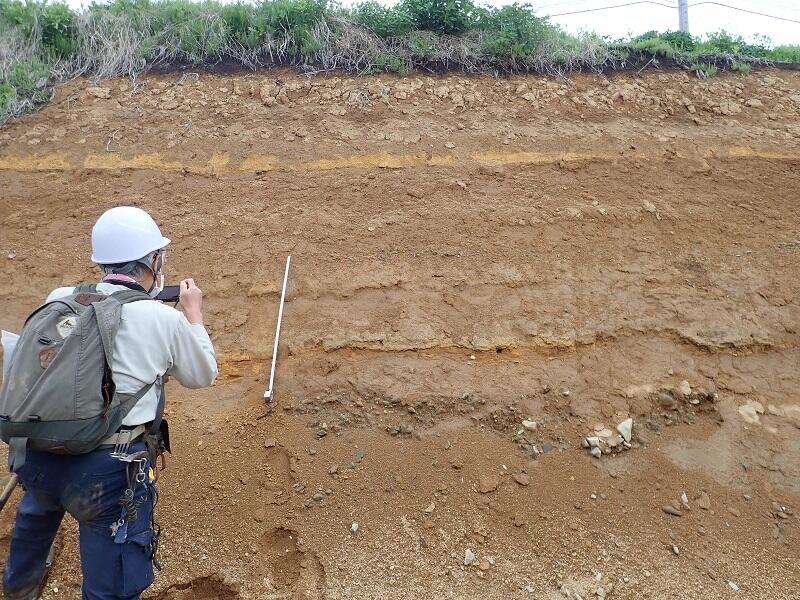Bulletin of the Geological Survey of Japan Top Page
Bulletin of the Geological Survey of Japan Vol.74 No.4 (2023)
Cover photograph | Table of Contents | Abstract
Cover photograph
New terrace outcrop along the Kuji River, Daigo Town, Ibaraki Prefecture
The Kuji River, which flows from southern Fukushima Prefecture to northern Ibaraki Prefecture, traverses the northern Kanto Mountains and the Kanto Plain. Numerous fluvial terraces have developed along the Kuji River, and recently, a new terrace outcrop has appeared. We surveyed the outcrop and obtained valuable information. The upper yellow-orange tephra and the middle orange-brown tephra in the photograph are the ~4.4-ka Akagi-Kanuma tephra and the ~6-ka Daisen-Kurayoshi tephra, respectively. For details, please refer to the article by Hosoi and Furusawa in the current issue. We wish to extend our gratitude to Dr. KOMATSUBARA Taku (Quaternary Basin Research Group,
GSJ), who helped us with field research on the terrace outcrops (person on the far left in the photograph).
(Photograph and Caption by HOSOI Jun))
Table of Contents
All the pages PDF : 74_04_full.pdf [29MB]
| Title | Author | |
|---|---|---|
| Report | ||
| Daisen-Kurayoshi tephra in fluvial terrace deposits along the Kuji River in northern Ibaraki Prefecture, Japan | HOSOI Jun and FURUSAWA Akira (p167-178) | 74_04_01.pdf[9.4MB] |
| Depositional age based on calcareous nannofossil biostratigraphy of the Miocene Uchiono Formation exposed in Daigo Town, Ibaraki Prefecture, Japan | UTSUNOMIYA Masayuki and HOSOI Jun (p179-185) | 74_04_02.pdf[18MB] |
Abstract
Daisen-Kurayoshi tephra in fluvial terrace deposits along the Kuji River in northern Ibaraki Prefecture, Japan
HOSOI Jun and FURUSAWA Akira
The Kuji River, which flows from southern Fukushima Prefecture to northern Ibaraki Prefecture, traverses the northern Kanto Mountains and the northeastern Kanto Plain. The ages of terraces along the Kuji River provide information on the uplift of the northern Kanto Mountains and the difference in the amount of tectonic uplift between the mountains and the plain. In this study, we newly discovered Daisen- Kurayoshi tephra (DKP) in a fluvial terrace deposit at Minamitage, Daigo Town. The tephra retains volcanic glass, whose refractive index, major chemical composition, and petrological characteristics are consistent with reported data for DKP tephra. Based on the terrace age and the height difference between the present riverbed and the terrace surfaces, it is possible to compare the terraces along the Kuji River in the northern Kanto Mountains and in the Kanto Plain (eastern Urizura Hills). The results suggest that there has been no significant difference in tectonic uplift between these regions for at least the last 60,000 years.
Depositional age based on calcareous nannofossil biostratigraphy of the Miocene Uchiono Formation exposed in Daigo Town, Ibaraki Prefecture, Japan
UTSUNOMIYA Masayuki and HOSOI Jun
Calcareous nannofossil assemblages in mudstone samples from the Miocene Uchiono Formation exposed in Daigo Town, Ibaraki Prefecture, Japan, were examined for the depositional ages. Five samples obtained from four sites yielded calcareous nannofossils indicating CN3 or CN4 zones, which are dated to 17.65–13.60 Ma (early–middle Miocene). These results are consistent with previous studies of radiometric ages of pyroclastic rocks as well as diatom biostratigraphy.
Geological Survey of Japan, AIST
- About GSJ
- Our Activities
- Purchase guide
-
Publications and Database
- information
- Bulletin of the Geological Survey of Japan
- bull2025(Vol.76)
- bull2024(Vol.75)
- bull2023(Vol.74)
- bull2022(Vol.73)
- bull2021(Vol.72)
- bull2020(Vol.71)
- bull2019(Vol.70)
- bull2018(Vol.69)
- bull2017(Vol.68)
- bull2016(Vol.67)
- bull2015(Vol.66)
- bull2014(Vol.65)
- bull2013(Vol.64)
- bull2012(Vol.63)
- bull2011(Vol.62)
- bull2010(Vol.61)
- bull2009(Vol.60)
- bull2008(Vol.59)
- bull2007(Vol.58)
- bull2006(Vol.57)
- bull2005(Vol.56)
- bull2004(Vol.55)
- bull2003(Vol.54)
- bull2002(Vol.53)
- bull2001(Vol.52)
- Bulletin of the Geological Survey of Japan(old)
- Annual Report on Active Fault and Paleoearthquake Researches
- Reports, Geological Survey of Japan
- CCOP-GSJ Groundwater Project Report
- CCOP Technical Bulletin
- Cruise Report
- Geological Hazards
- Learning and Education
- GSJ Database Collection
- Collection of links


